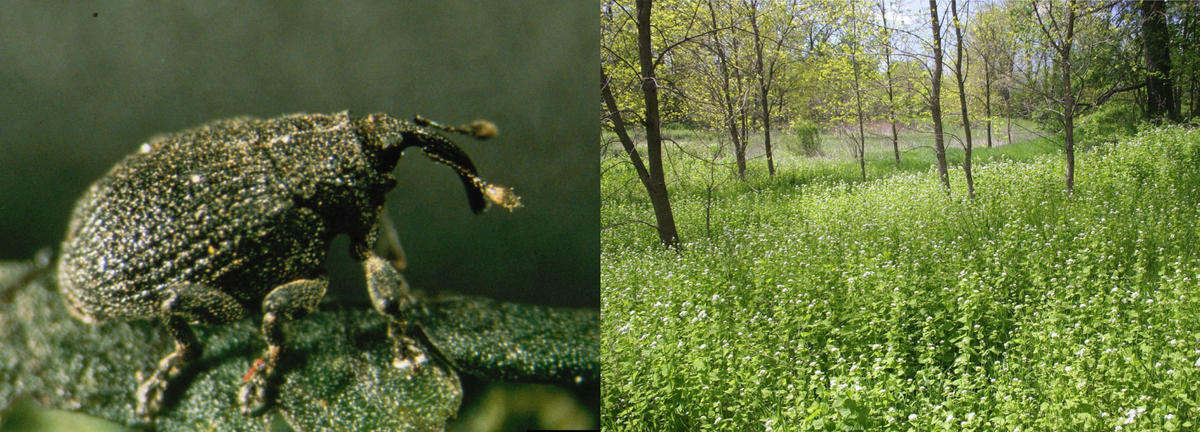
Left: univoltine weevil; right: stand of garlic mustard
Image credits
Left: "Univoltine root mining weevil " by Hariet Hinz and Ester Gerber, CABI Biosciences, Bugwood.org is licensed under CC BY-NC 3.0
Right: "Garlic mustard" by Steven Katovich, USDA Forest Service, Bugwood.org is licensed under CC BY-NC 3.0
Background
Garlic mustard (Alliaria petiolata) is a noxious biennial herb whose invasive range includes 37 US states and 6 Canadian provinces. Current management options are limited to time-intensive manual removal or costly chemical control.
Although garlic mustard was originally introduced from Europe for use in cooking, few insects or wildlife will readily eat the plant. One group of beetles, however, does feed almost exclusively on garlic mustard: European weevils of the genus Ceutorhynchus. These non-native weevils present an exciting opportunity for a long-term, sustainable biocontrol program in the United States. The long-term goal of this project is the safe, effective implementation of such a program.
Experiments will focus on Ceutorhynchus scrobicollis and Ceutorhynchus constrictus, which are known to feed on garlic mustard’s leafy crown and seeds, respectively. C. constrictus can reduce garlic mustard seed production by up to 60.5%, and field attack rates of C. scrobicollis can reach 100%.
Researchers will expand on prior work to determine the weevils’ host plant range, impact on native plant populations and likely distribution following release. Together, these data will establish whether Ceutorhynchus poses a threat to nontarget plants as it moves forward towards USDA approval for field release.
Research questions
- What is the host range of the seed feeder weevil C. constrictus?
- What impact does the crown eater weevil C. scrobicollis have on key native plants, including Brassica species that are biologically similar to garlic mustard?
- What is the expected distribution of C. scrobicollis and C. constrictus should they be released for biocontrol?
- What method will be used to meaningfully monitor garlic mustard control at weevil release sites?
Outcomes
This research group was integral in the release of Ceutorhynchus scrobicollis in Canada, the first biological control agent for garlic mustard in North America. We moved closer to federal regulatory approval to release C. scrobicollis and C. constrictus in the United States. When achieved, these will offer the first viable control of garlic mustard in Minnesota woodlands.
Publications
- Vernalization required to induce flowering in rosettes of garlic mustard (Alliaria petiolata) (Invasive Plant Science and Management, 2022)
- Lessons learned: rearing the crown-boring weevil, Ceutorhynchus scrobicollis, in containment for biological control of garlic mustard (Alliaria petiolata) (Great Lakes Entomologist, 2020)
Project artifacts
- Generations (Python package by Mary Marek-Spartz)
- Climate Match (ShinyR web application by Mary Marek-Spartz)
Outreach
- Upper Midwest Invasive Species Conference, 2022
- Animal Plant Health Inspection Service (APHIS), Plant Protection and Quarantine (PPQ), TAG, 2021
- Undergraduate Research Opportunities Program Spring Symposium, 2020
- Joint North Central Branch and Southwestern Branch of ESA meeting, 2020
- Strange Loop Conference, 2019
- Entomological Society of America Annual Conference, 2019
- International Symposium on the Biological Control of Weeds, 2018
- XV International Symposium on Biological Control of Weeds, 2018
- Upper Midwest Invasive Species Conference, 2018
- North Central Weed Science Society Conference, 2018
News and media
- Phenology of garlic mustard and biocontrol agents (infographic authored by Mary Marek-Spartz)